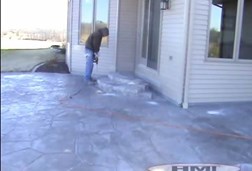- Concrete Repair Home
- Surface Repairs
- Structural Repairs
- Slab Repairs
- Concrete Crack Repair
- Common Concrete Repairs
- Stamped Concrete Repair
- Driveway Repair
- Pool Deck Repair
- Fix Spalling Concrete
- Concrete Repair Methods & Systems
- Concrete Crack Injection for Basements
- Why Concrete Cracks
- Sunken Concrete Foundations
- Repairing Bowed Basement Walls Using a Carbon-Fiber-Reinforced Grid
- Concrete Raising & Leveling Equipment
Leveling Uneven Patios, Pool decks, Walkways, Driveways & More.
Section Sponsor

Concrete Crack Repair Kits
Polyurethane Injection System Offers a New Alternative for Raising Sunken Concrete
Traditional mudjacking, or slabjacking, is a remedy that’s been used for decades to raise sunken slabs. Now there’s a newer, less labor-intensive alternative available from Hydraulic Mudpumps Inc. that replaces the cement-based grout mixture typically used for slabjacking with a two-part polyurethane that reacts and expands with enough force to fill voids and raise concrete.
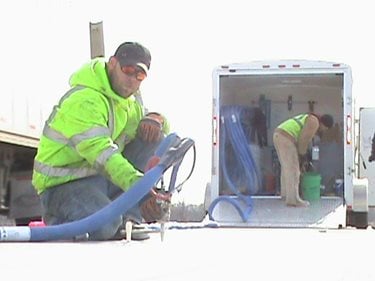
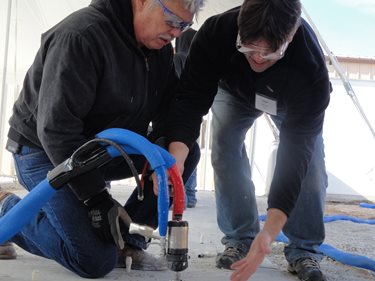 Everything needed for polyurethane concrete slab raising can be transported in a trailer or the back of a truck. The material is delivered to the injection port directly through the hose, eliminating hauling and waste.
The two liquid components that combine and react to create the polyurethane foam are mixed at the tip of the injection gun. When the two liquids combine, the foam expands 20 to 25 times its volume within 15 seconds.
Everything needed for polyurethane concrete slab raising can be transported in a trailer or the back of a truck. The material is delivered to the injection port directly through the hose, eliminating hauling and waste.
The two liquid components that combine and react to create the polyurethane foam are mixed at the tip of the injection gun. When the two liquids combine, the foam expands 20 to 25 times its volume within 15 seconds.
The polyurethane concrete lifting material from HMI is available in several formulas designed for different applications, including raising highway and industrial slabs, raising sidewalks and other residential concrete, or filling voids. One of the key benefits of using the polyurethane is that it’s preformulated with the exact characteristics needed for specific jobs.
Improved efficiencyMudjacking typically involves shoveling the grout material into a mixer, adding water and pumping agents to achieve a good consistency, and then dumping that slurry into a mudjacking pump hopper. The pump is then mobilized to the area to be raised. When the hopper is empty, the pump must be hauled back to the mixing area to be refilled with another load. With polyurethane injection, many of these steps are eliminated.
“Compared to moving tons of material with heavy equipment and shovels, the polyurethane material is much less labor-intensive to transport and work with,” says Jen Mazur of HMI. “The process of polyurethane concrete raising starts with pulling out a hose and injection gun, attaching the gun to an injection port, and pulling the trigger. When the equipment is shut down, the materials can stay in the hose, and there is no wasted material that has been premixed. The only jobsite cleanup is to patch the injection holes.”
The two liquid components that mix to create the polyurethane foam are kept separate in drums or totes until they are mixed at the tip of the injection gun. When the two liquids combine and react, the foam expands 20 to 25 times its volume within 15 seconds. Fifteen minutes after the material sets, it reaches full compressive strength.
Hands-on training offeredFor contractors who are thinking about starting a polyurethane concrete lifting business, HMI offers training seminars that educate attendees on how to raise concrete, where to drill the holes, how to use the equipment, how much material to inject and the process of completing a job. Other topics discussed include how to estimate jobs, marketing, and business operation. “This is all reinforced with hands-on training held in our indoor facility,” says Mazur.
Depending on the application, contractors can purchase a 14-foot enclosed trailer system designed for residential, industrial, and municipal polyurethane concrete lifting projects or a truck-ready system with the capacity to handle larger industrial, municipal, and highway jobs. All the equipment needed to drill the injection holes and to mix, pump and inject the polyurethane is included.
For more information:
Hydraulic Mudpumps Inc. - Manitowoc, Wis.
800-626-2464
hmicompany.com
 Concrete Foundation Repair Kits
Foundation Crack repair kits for any size job for Contractors, Homeowners, & D-I-Y owners
Concrete Foundation Repair Kits
Foundation Crack repair kits for any size job for Contractors, Homeowners, & D-I-Y owners
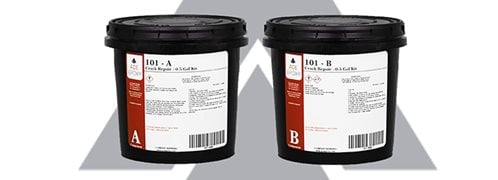 Epoxy Crack Repair
$39.86
Epoxy Crack Repair
$39.86
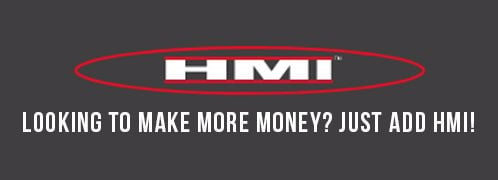 Concrete Lifting
Expand your business offering
Concrete Lifting
Expand your business offering
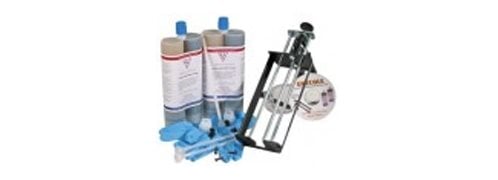 Concrete Slab Repair
Kits for concrete slab repair
Concrete Slab Repair
Kits for concrete slab repair
 High Performance Concrete Repair
Fast setting mix for structural repairs
High Performance Concrete Repair
Fast setting mix for structural repairs
 Divot Patch - Concrete Repair
15-minute set time
Divot Patch - Concrete Repair
15-minute set time
